Mixed Bag Vol. 5
There are many bottles in my bag. I get them one after another. It calls for a wine tasting event!
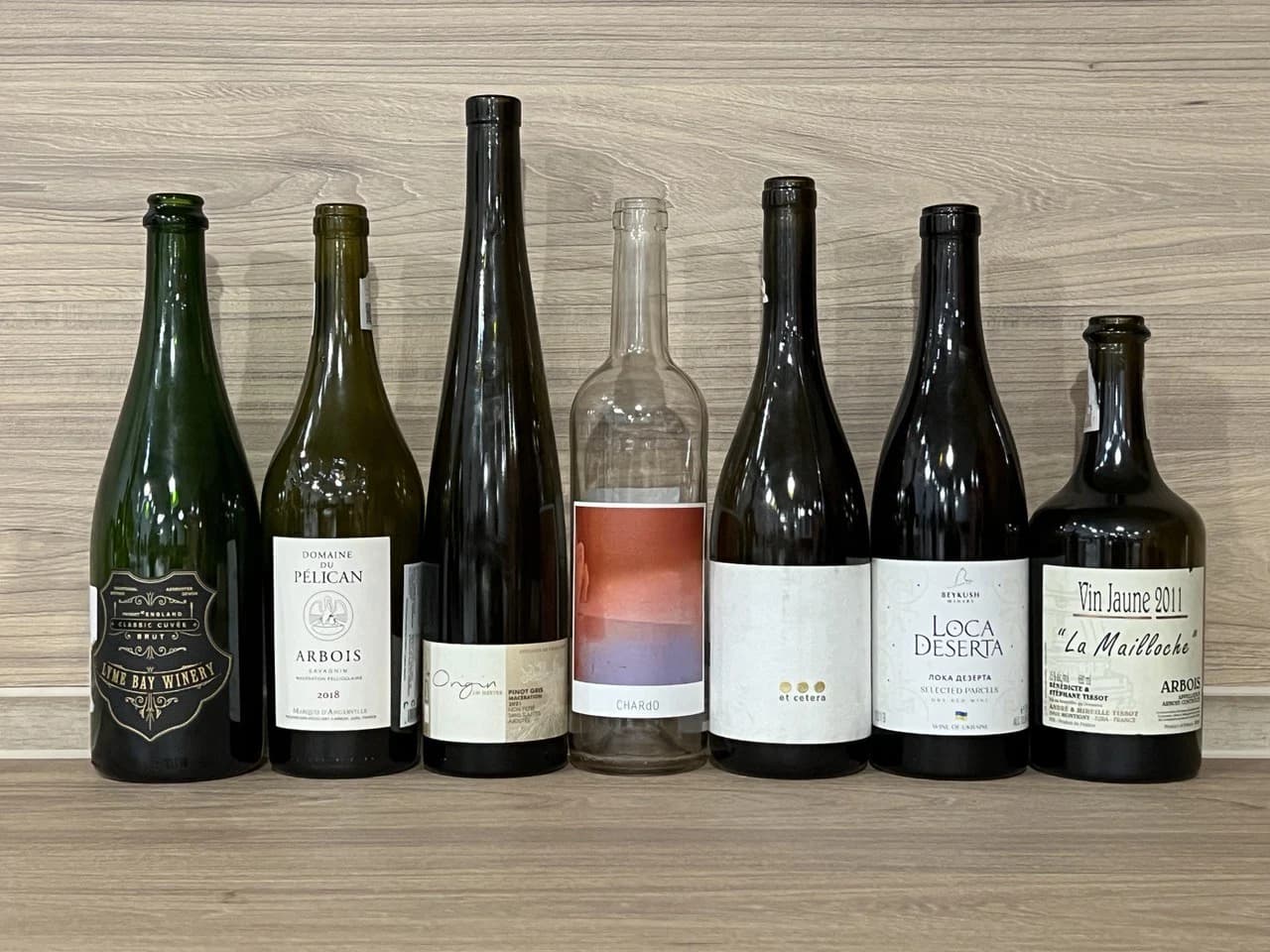
After tasting so many wines from Italy, it's time to turn to our favourite source of wines - my endless bag. And it's an excellent opportunity to explore the world of wine without any specific ties. Sparkling from England? You've got it! Moldova? Ukraine? There are no rules. Just an attempt to build a sensual story.
Lyme Bay Classic Cuvée Brut 2016
- Region
- England » Devon
- Type
- white traditional sparkling, brut
- Producer
- Vintage
- 2016
- Disgorged
- 2021-04
- On lees
- >24 months
- Grapes
- Pinot Noir, Chardonnay
- Alcohol
- 12
- Volume
- 750 mL

This wine secured the 🏅 4th place in our wine tasting lineup.
Yup, it's a traditional sparkling wine from Devon, England. And before you start asking too many questions, let me assure you that England is an emerging winemaking region. Yes, over the centuries, the English has gained a reputation as wine consumers. Apart from being affiliated with both obscenely large volumes of drunkenness and snobbish appreciation, they played and still play an important role in the wine world, including winemaking.
And imagine, the history of winemaking in this domain spans back to ancient Romans, who introduced locals to virtues of civilisation, including wine. Funny enough, it was possible thanks to climate anomalies as it happened during Roman Climatic Optimum, a period with a relatively warm climate.
Why do I find it funny? Because the English climate was not well suited for vines. Would they go to such lengths to secure wine supply from France, Portugal and Spain (depending on the geopolitical situation) if they had their own wine 'industry'? My hunch - no, they would not. So all this long history is nice and games, but the wine produced in England didn't satisfy locals. Until the revival of viticulture in the 1970s onwards. So I find it funny because it is possibly helped by a rising local temperature due to global warming (another climate 'anomaly'), making many southern parts dry and warm enough to grow grapes of high quality.
Over time the English came from sweet wines to sparkling and dry still wines. According to Wine Folly (not sure where this information actually comes from), 84% of all produced English wines are sparkling or still white. And it kind of makes senses if you think about it. Despite the climate change, England is still a cold climate country. And just like with Champagne, grapes are high in acidity. In such a situation, it is a good decision to produce traditional sparkling wines.
Lyme Bay Winery is located in Devon, South West corner of England. But the winery sources their grapes across the country, and in the case of Classic Cuvée, all grapes come from Crouch Valley Vineyard (Maldon, Essex).
The Classic Cuvée is a blend of Pinot Noir (81%) and Chardonnay (19%). The grapes are picked by hand and pressed whole-cluster. The fermentation started after a slow, cold and natural settle, partially in oak barriques (33%) and in stainless steel (67%). In the following spring, the wine is blended and bottled for the second fermentation. It remained on lees for a minimum of 24 months.
Domaine du Pélican Savagnin Macération Pelliculaire 2018
- Region
- France » Jura » Arbois AOC
- Type
- white still, dry
- Producer
- Vintage
- 2018
- Grapes
- Savagnin
- Alcohol
- 13.5
- Volume
- 750 mL

This wine secured the 🏅 7th place in our wine tasting lineup.
Guillaume d'Angerville, current owner of famous Le Domaine Marquis d'Angerville from Bourgogne, decided to create a new project in Jura after tasting a single bottle - Tissot’s Chardonnay Arbois Les Bruyères 2005.
I tasted this bottle blind in a restaurant in Paris that I often go to. I always tell the sommelier to give me something blind and the only rule is that it has to be outside Burgundy. When he brought me this wine, I said, 'You forgot the rule, you brought me a wine from Burgundy.' And he said, 'I am afraid you're wrong.'
Guillaume d’Angerville
I understand that now you want to taste this wine. But unfortunately, even 2017 is not available in Ukraine anymore. But I guess a bottle of Savagnin by Domaine du Pélican is a good alternative. Besides, it's 'Macération Pelliculaire'! I bet you are already excited about tasting macerated Savagnin but hold your horses.
Macération pelliculaire means pre-fermentation maceration. Numerous English sources online (example) draw an equivalence between orange wines and Macération Pelliculaire, but it's a matter of definition of the former term. For example, French Wikipedia (aye, a trustworthy source, but some other sources are similar in this) states that orange wine requires fermentation on skins. Without too many details, pre-fermentation maceration is used to enhance the wine with aromatics and colour but without tannin extraction (or at least minimal). Interestingly, tannin is more soluble in an alcoholic environment (citation needed). And the cooler this environment, the less tannin is extracted. And before fermentation, there is no alcohol. Bam!
So what's the point? Unlike Savagnin Ouillé we tasted almost a year ago, this specific Savagnin is slightly macerated before fermentation. And hence, more expressive. On the other hand, all sources (example) I found say it spent 10 days on skins, which puzzles me. Why? Because 10 days for pre-fermentation maceration sounds too much. Unless it's done in a cold environment to block fermentation. Unfortunately, there is no official technical information from the producer. In any case, 2018 is the first release of this wine. So our best course of action is to drink this wine. And figure out nuances with the help of our senses.
J.M Dreyer Origin Pinot Gris Macération 2021
- Region
- France » Alsace » Alsace AOC
- Type
- white still, dry
- Producer
- Vintage
- 2021
- Grapes
- Pinot Gris
- Alcohol
- 12.5
- Sugar
- 1.2
- Volume
- 750 mL
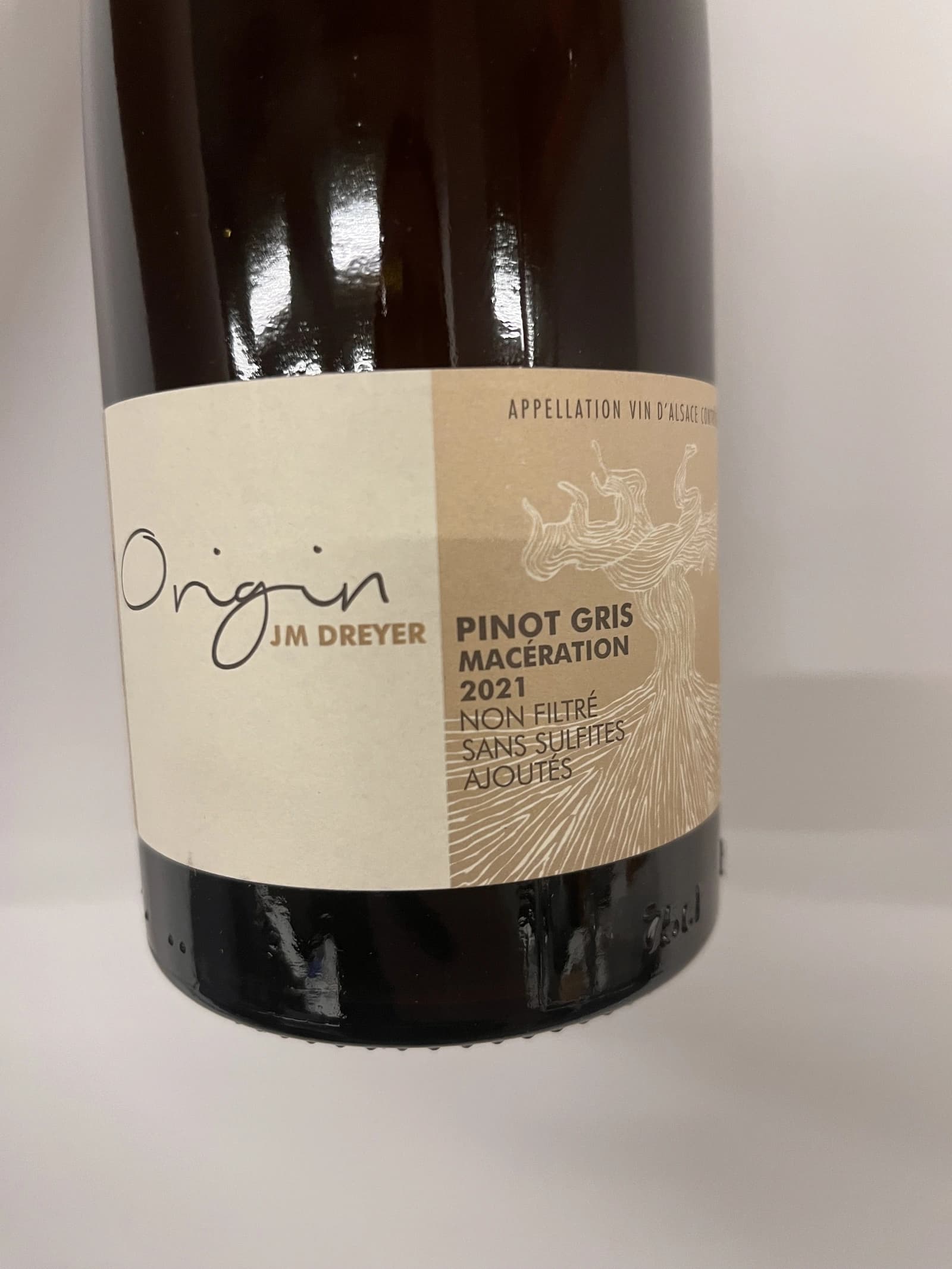
This wine secured the 🏅 5th place in our wine tasting lineup.
Don't confuse what you need with what the wine needs.
— Jean-Mark Dreyer
Jean-Marc Dreyer is a small zero-zero producer from scenic Rosheim in Alsace, 25km southwest of Strasbourg. Jean-Marc acquired a wine diploma at the local Obernai wine school and sharpened his approach and attitude with Patrick Meyer in nearby Nothalten. Patrick is one of the pioneers of the natural wine scene in Alsace.
The vineyards range over 6 hectares and are split between 25 parcels dotted around the hillsides that surround Rosheim. The soils are predominately a clay-limestone mix. The conversion to biodynamics started in 2003, but Jean-Marc went to full organic certification only in 2014.
Jean-Marc Dreyer specialises in macerated whites wines. His Origin series consists of white grape varietal maceration cuvées (Sylvaner, Auxerrois, Riesling, Muscat, Gewürztraminer and Pinot Gris). They go through 10-20 days of maceration and then mature in a wooden foudre for 11 months.
Sarnin-Berrux CHARdO 2020
- Region
- France » Vin de France
- Type
- rose still, dry
- Producer
- Wine
- Vintage
- 2020
- Grapes
- Chardonnay, Pinot Noir, Gamay
- Alcohol
- 14
- Sugar
- 3
- Volume
- 750 mL
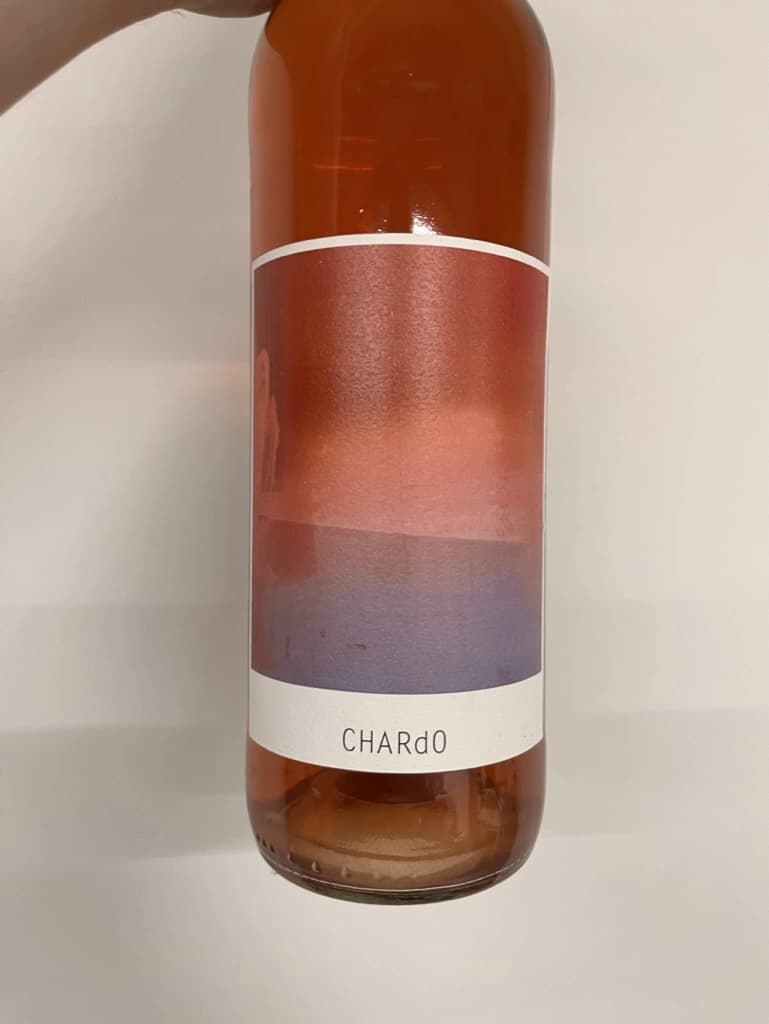
This wine secured the 🥈 2nd place in our wine tasting lineup.
After tasting macerated Pinot Gris, let's turn to Chardonnay-based rosé wine. Huh? Why, of course, this wine is made not only of Chardonnay but also of Pinot Noir and Gamay. Otherwise, it wouldn't be a rosé wine.
Most rosé wines are made using the limited contact skin method or direct pressing method, where the red grapes are left in contact with skins for a short time (6-48 hours). There is also the Saignée method (bleeding) for making concentrated red wines with rosé wine as a subproduct (we actually tasted Saignée wine by Sarnin-Berrux a few months ago).
And, of course, there is the least prestigious method - blending. What can be easier, right? Just blend some red and white to get rosé. But most PDO wines in Europe prohibit the usage of this method, save for Champagne.
Sarnin-Berrux is a negocee from Burgundy. Two downshifters quit their job to start a winery in a small town (with only 250 people). CHARDo is a blend of Chardonnay (80%) and Pinot Noir (10%) from Côtes de Beaune with some Gamay (10%) from Régnié-Durette. Chardonnay and Pinot are direct-pressed and fermented together with Gamay must from Saignée cuvée. Aged in neutral wood barrel for 6 months.
Et Cetera Pinot Noir 2018
- Region
- Moldova » Ștefan Vodă
- Type
- red still, dry
- Producer
- Wine
- Vintage
- 2018
- Grapes
- Pinot Noir
- Alcohol
- 13.5
- Volume
- 750 mL
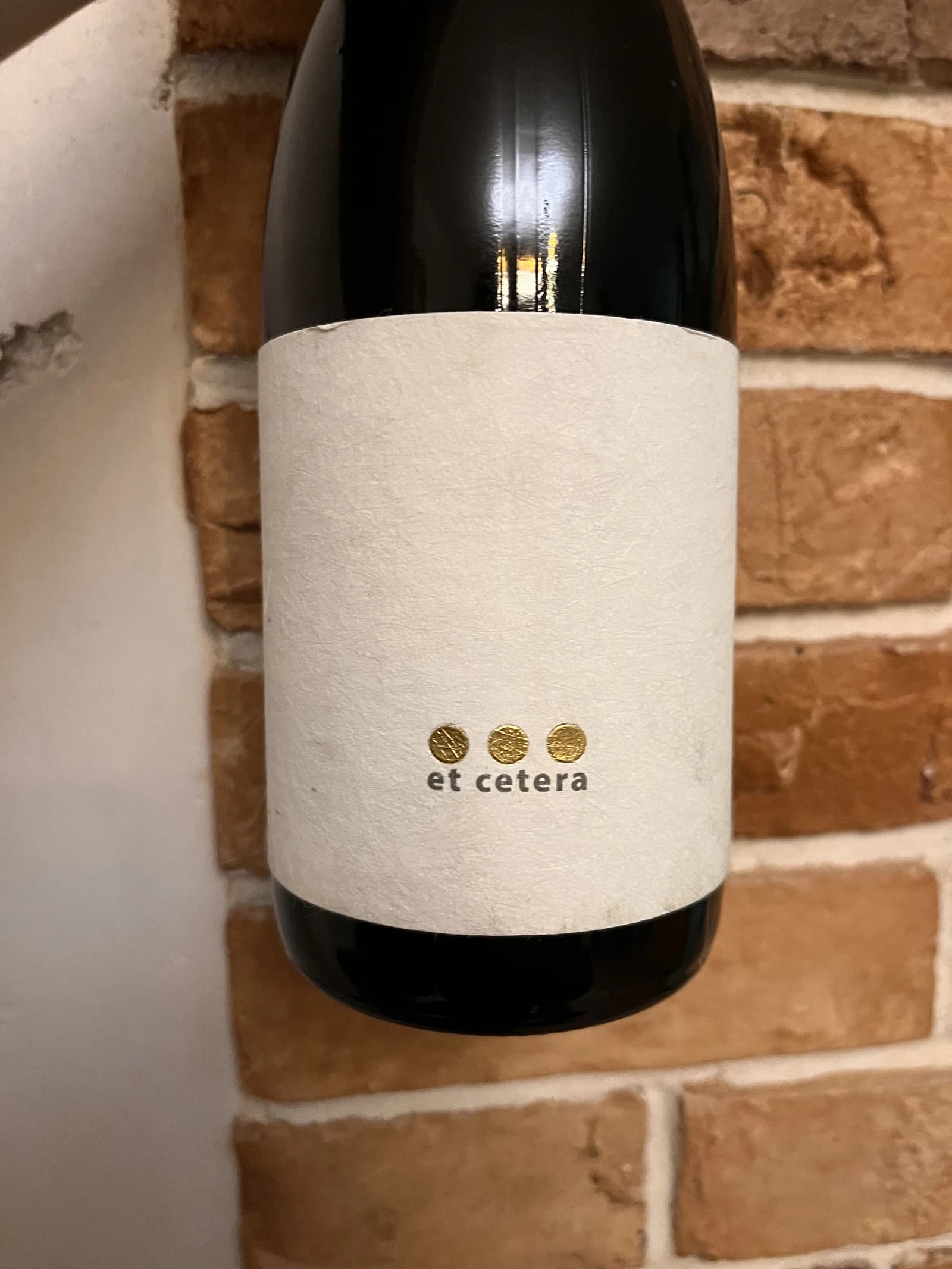
This wine secured the 🥉 3rd place in our wine tasting lineup.
A young family-owned winery from Ștefan Vodă, Moldova. Alexandru Luchianov purchased the land in 2002 and started to grow vines in 2003. The first harvest and bottling were rewarded in a local competition in 2005. In 2006 his brother Igor joined this project.
On 24.2 ha, they cultivate Merlot, Cabernet Franc, Fetească Neagră, Saperavi, Carmenere, Cabernet Sauvignon, Pinot Noir, Marselan, Albarosa, Chardonnay, Sauvignon Blanc and Viognier.
Grapes from this wine come from young vines (average age is 4 years). In total Et Cetera owns 1.2 ha of Pinot Noir.
Beykush Loca Deserta 2019
- Region
- Ukraine » Mykolaiv Oblast
- Type
- red still, dry
- Producer
- Wine
- Vintage
- 2019
- Grapes
- Merlot, Cabernet Sauvignon, Tempranillo, Cabernet Franc, Rubin, Pinot Noir
- Alcohol
- 13.5
- Volume
- 750 mL

This wine secured the 🏅 6th place in our wine tasting lineup.
It's only fair to bring a bottle of Ukrainian wine after one from Moldova, right? Beykush is definitely among the most known new-wave wineries. The name comes after Cape Beykush in Mykolaiv Oblast (despite what some sources claim, it's not Odesa). On scenic plots, they grow international varieties like Chardonnay, Pinot Gris, Riesling, Sauvignon Blanc, Pinot Noir, Merlot and Cabernet Sauvignon. In addition, they have plenty of Rkatsiteli and Saperavi with tiny plots of experimental Telti-Kuruk, Albariño, Tempranillo, Pinotage and Malbec.
Loca Deserta is a blend of Merlot (33%), Cabernet Sauvignon (21%), Tempranillo "appassito" (21%), Cabernet Franc (10%), Rubin (10%) and Pinot Noir (5%). All grapes are fermented separately in stainless steel tanks. And then, they are aged in oak barrels for 30 months before blending. I tasted this wine by accident (literally on the checkout at Good Wine in the morning) and enjoyed it enough to bring it for our little party.
Andre et Mireille Tissot La Mailloche Vin Jaune 2011
- Region
- France » Jura » Arbois AOC
- Type
- white still, dry
- Producer
- Vintage
- 2011
- Grapes
- Savagnin
- Alcohol
- 15
- Volume
- 620 mL
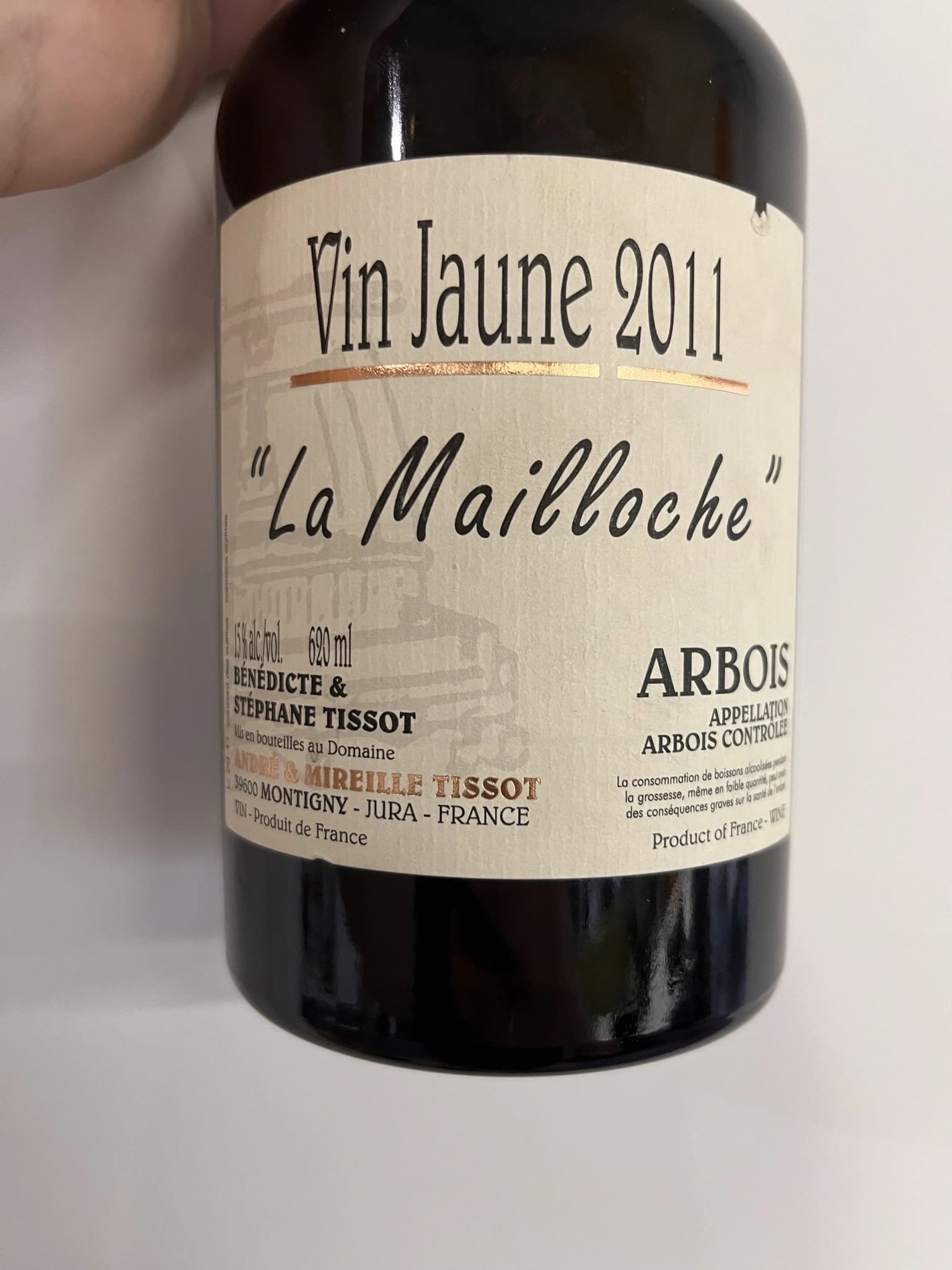
This wine secured the 🥇 1st place in our wine tasting lineup.
Those who drink with me know I am an average vin jaune enjoyer. Aside from drinking these marvellous wines, I love to spy on other people's reactions when they taste this style for the first time. Ivan Omelchenko rarely brings a bottle of vin jaune, so I figured to gather the subjects myself.
Vin jaune (literally, yellow wine) is a Jura white wine matured in a barrel under a film of yeast, known as the voile, on the wine's surface. The result is unique and hard to mistake. It's really better to taste it to decide which side of the love-hate relationship you are on. Bruised apple and nutty aromas mixed with maple syrup, caramel or even curry. Sharp and light on the palate. The result is similar to dry fino Jerez, but vin jaune is not fortified. In Jerez, the film is so thick that it creates a protective barrier that inhibits oxygen exposure. This phenomenon is referred to as biological ageing. In vin jaune, the yeast layer is often thinner and not totally hermetic. Hence the resulting wine is 'yellow'.
Yeast is a simple fungus. Give it some glucose - and in the presence of oxygen, the yeast will utilise glucose to produce large amounts of energy for the cell and some intermediates the cell needs to function. Take away the oxygen, and the cell will continue its metabolic functions (e.g. glycolysis), but it will rely on the reduction of acetaldehyde into ethanol to keep the metabolism going. Most of the yeast strains responsible for alcoholic fermentation in wine generally die off once all fermentable sugars have been consumed, leaving only the unfermentable pentose (what we call residual sugar in still wine). However, some strains can spontaneously transition to an oxidative mode, metabolising glycerol, alcohol, and volatile acids in wine. So instead of dying off into fine lees, they float on the surface of the wine and develop a waxy coating. They multiply and spread out across the surface, forming a continuous layer. Voilà! Voile!
For a voile to form, certain conditions must be met.
- A specific alcohol range must be reached and/or maintained for the yeast to thrive. The flor yeast in Jerez requires from 14.5% to 16% abv, which is achieved by fortification. The voile requires slightly lower alcohol levels (13% to 15%), so there is no need for fortification in vin jaune.
- A sufficient oxygen level is required. For vin jaune, grapes are fermented slowly and kept in small (228L) old oak casks. They are not topped up, so an air gap appears above the wine due to evaporation.
- A cooler and wetter environment is preferred. In such conditions, the flor layer will generally be thicker and give more pronounced freshness and yeast-driven aromatics.
The voile typically takes two to three years to develop fully. During this time, the wine is exposed to slight levels of oxidation (in vin jaune, the film is not hermetic) that provoke chemical changes that produce acetaldehyde and the aroma compound of sotolon. These compounds contribute to the unique flavours and aromas associated with vin jaune. Acetaldehyde gives distinctive bruised apple and nutty aromas. Sotolon gives notes of maple syrup or caramel at low levels and exotic spice aromas like curry at higher concentrations.
The desired result is achieved in at least six years. After the allotted time, only about 62% of the original wine remains. The vin jaune is bottled in special squat bottles that hold 62 cl, called clavelins. Historically the bottle size alludes to the amount of wine left over after six years of ageing and evaporation.
Wow, that was a long ride. Let's relax like these little people in kindergarten. So sing with me. What is flor? Baby (aka oxygen), don't hurt me. Easy to remember, right? I reckon this joke is better than singing the same tune while pronouncing Vladyslav.
Resources
- Roman Climatic Optimum. Wikipedia
- Lyme Bay Winery (for some information I had to use https://archive.org/web/)
- What does “macération pelliculaire” mean? Oray Wine, 2022
- Domaine du Pelican Arbois Savagnin 'Maceration Pelliculaire' 2018. Verve Wine
- Macération pelliculaire. Wikipedia.
- Et Cetera
- Flor power: the effects of biological ageing in wine. Jacky Blisson MW, 2001
- Optimal Conditions for the Formation of Sotolon from -Ketobutyric Acid in the French "Vin Jaune". Pham Thu Thuy, Guichard Elisabeth, Schlich Pascal and Charpentier Claudine, J. Agric. Food Chem., 1995
- Yeast in winemaking. Wikipedia.
- Vin jaune. Wikipedia.
- Jean-Marc DREYER. Back In Alsace
- Jean Marc Dreyer: Refined wines from Alsace. Living Wines
Aye, I use Wikipedia, and I am not ashamed.